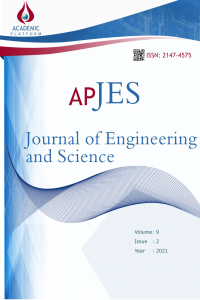Abstract
In this study, a four-cylinder simplified diesel engine model has been developed with a model-based design approach. In the modeling of the diesel engine, the signals coming from and going to the ECU are taken as basis. The injection time coming from the ECU and the duty cycle of the high pressure fuel pump are the main inputs. The outputs of the diesel engine model to the ECU are the rail pressure, crank and cam signals generated according to engine speed. Measurement-based simplifications were used in creating the model. The model was created in the Simulink environment. It has been observed that the outputs obtained by simulation of the model created are similar to the results obtained in real engines and other experimental studies.
References
- T. Erkkinen, and K. Zwaanenburg,, "A Seamless Implementation of Model-Based Design Applied to a New Fuel Control Feature for an Existing Engine ECU," SAE Technical Paper 2006-01-0612, 2006.
- Schulze, T., Wiedemeier, M., and Schuette, H., "Crank Angle - Based Diesel Engine Modeling for Hardware-in-the-Loop Applications with In-Cylinder Pressure Sensors," SAE Technical Paper 2007-01-1303, 2007, https://doi.org/10.4271/2007-01-1303.
- Zeng, Jiyuan,”Modelling and Simulation of the Diesel Engine Injection Systems”, M.S. Thesis, 2019.
- Lino, Paolo & Maione, Bruno & Rizzo, Alessandro. “A control-oriented model of a Common Rail injection system for diesel engines”. IEEE International Conference on Emerging Technologies and Factory Automation, ETFA. 1. 7 pp. - 563. 10.1109/ETFA.2005.1612572. (2005).
- URL: http://www.goapr.co.uk/ products/ hpfp_20t_ea888_gen3.html (Accessed: 18-Dec-2020).
- Tsai, Wen-Chang & Zhan, Tung-Sheng. (2018). An Experimental Characterization for Injection Quantity of a High-pressure Injector in GDI Engines. Journal of Low Power Electronics and Applications. 8. 36. 10.3390/jlpea8040036.
- URL:https://www.dspace.com/en/inc/home/products/sw/automotive_simulation_models/produkte_asm/asm_engine_models.cfm (Accessed: 18-Dec-2020).
- URL: https://www.etas.com/en/products/es4000-es5000-hil-hardware.php (Accessed: 18-Dec-2020).
- URL: https://www.woodward.com/ (Accessed: 30-Nov-2020).
- URL: https://www.pi-innovo.com/ (Accessed: 30-Nov-2020).
- Samuel, Jensen & Muthyala, Paul Pramod & Ramesh, A. & Thomas, Anand & Prasad, N. & Kumarasamy, A. “Development of a Fuel Quantity based Engine Control Unit Software Architecture”. Defence Science Journal. 69. 203-207. 10.14429/dsj.69.14420. (2019).
- Knauder, Christoph & Allmaier, Hannes & Sander, David & Sams, Theodor. “Investigations of the Friction Losses of Different Engine Concepts. Part 1: A Combined Approach for Applying Subassembly-Resolved Friction Loss Analysis on a Modern Passenger-Car Diesel Engine.” Lubricants. 7. 39. 10.3390/lubricants7050039. (2019).
- Hong, Seungwoo & Shin, Jaewook & Sunwoo, Myoungho. “Common rail pressure controller for diesel engines using an empirical model.” 2012 IEEE Vehicle Power and Propulsion Conference, VPPC 2012. 887-892. 10.1109/VPPC.2012.6422700. (2012).
- Gulgonul, Senol & Sözbir, Nedim. “Crank Cam Signal Generator Using NXP Model Based Design Toolbox”. Academic Perspective Procedia. 2. 687-695. 10.33793/acperpro.02.03.75. (2019)
Abstract
In this study, a four-cylinder simplified diesel engine model has been developed with a model-based design approach. In the modeling of the diesel engine, the signals coming from and going to the ECU are taken as basis. The injection time coming from the ECU and the duty cycle of the high pressure fuel pump are the main inputs. The outputs of the diesel engine model to the ECU are the rail pressure, crank and cam signals generated according to engine speed. Measurement-based simplifications were used in creating the model. The model was created in the Simulink environment. It has been observed that the outputs obtained by simulation of the model created are similar to the results obtained in real engines and other experimental studies.
Keywords
Diesel engine model model based design idle speed control common rail model rail pressure control
References
- T. Erkkinen, and K. Zwaanenburg,, "A Seamless Implementation of Model-Based Design Applied to a New Fuel Control Feature for an Existing Engine ECU," SAE Technical Paper 2006-01-0612, 2006.
- Schulze, T., Wiedemeier, M., and Schuette, H., "Crank Angle - Based Diesel Engine Modeling for Hardware-in-the-Loop Applications with In-Cylinder Pressure Sensors," SAE Technical Paper 2007-01-1303, 2007, https://doi.org/10.4271/2007-01-1303.
- Zeng, Jiyuan,”Modelling and Simulation of the Diesel Engine Injection Systems”, M.S. Thesis, 2019.
- Lino, Paolo & Maione, Bruno & Rizzo, Alessandro. “A control-oriented model of a Common Rail injection system for diesel engines”. IEEE International Conference on Emerging Technologies and Factory Automation, ETFA. 1. 7 pp. - 563. 10.1109/ETFA.2005.1612572. (2005).
- URL: http://www.goapr.co.uk/ products/ hpfp_20t_ea888_gen3.html (Accessed: 18-Dec-2020).
- Tsai, Wen-Chang & Zhan, Tung-Sheng. (2018). An Experimental Characterization for Injection Quantity of a High-pressure Injector in GDI Engines. Journal of Low Power Electronics and Applications. 8. 36. 10.3390/jlpea8040036.
- URL:https://www.dspace.com/en/inc/home/products/sw/automotive_simulation_models/produkte_asm/asm_engine_models.cfm (Accessed: 18-Dec-2020).
- URL: https://www.etas.com/en/products/es4000-es5000-hil-hardware.php (Accessed: 18-Dec-2020).
- URL: https://www.woodward.com/ (Accessed: 30-Nov-2020).
- URL: https://www.pi-innovo.com/ (Accessed: 30-Nov-2020).
- Samuel, Jensen & Muthyala, Paul Pramod & Ramesh, A. & Thomas, Anand & Prasad, N. & Kumarasamy, A. “Development of a Fuel Quantity based Engine Control Unit Software Architecture”. Defence Science Journal. 69. 203-207. 10.14429/dsj.69.14420. (2019).
- Knauder, Christoph & Allmaier, Hannes & Sander, David & Sams, Theodor. “Investigations of the Friction Losses of Different Engine Concepts. Part 1: A Combined Approach for Applying Subassembly-Resolved Friction Loss Analysis on a Modern Passenger-Car Diesel Engine.” Lubricants. 7. 39. 10.3390/lubricants7050039. (2019).
- Hong, Seungwoo & Shin, Jaewook & Sunwoo, Myoungho. “Common rail pressure controller for diesel engines using an empirical model.” 2012 IEEE Vehicle Power and Propulsion Conference, VPPC 2012. 887-892. 10.1109/VPPC.2012.6422700. (2012).
- Gulgonul, Senol & Sözbir, Nedim. “Crank Cam Signal Generator Using NXP Model Based Design Toolbox”. Academic Perspective Procedia. 2. 687-695. 10.33793/acperpro.02.03.75. (2019)
Details
| Primary Language | English |
|---|---|
| Subjects | Engineering |
| Journal Section | Articles |
| Authors | |
| Publication Date | May 28, 2021 |
| Submission Date | April 29, 2020 |
| Published in Issue | Year 2021 Volume: 9 Issue: 2 |


